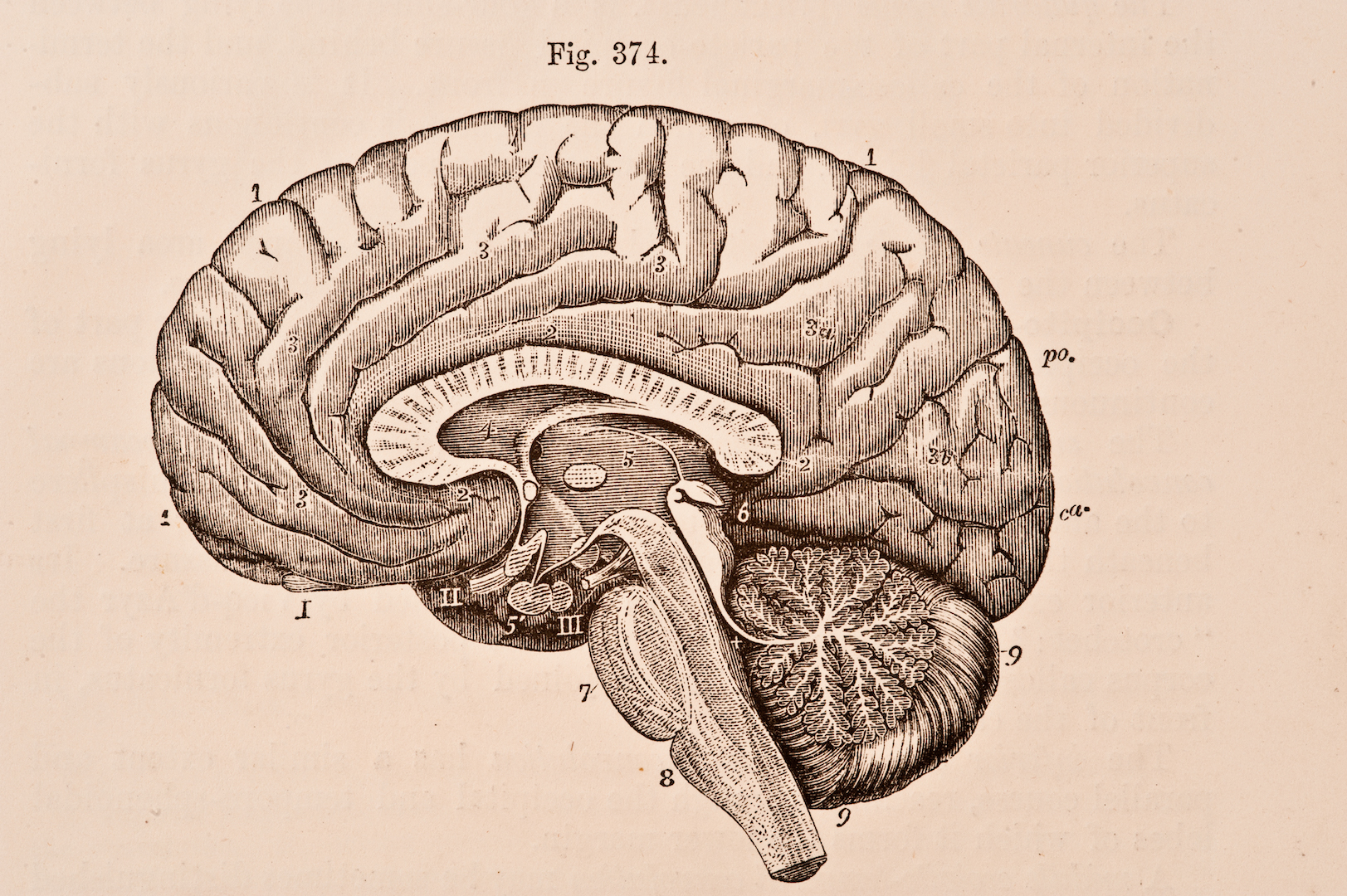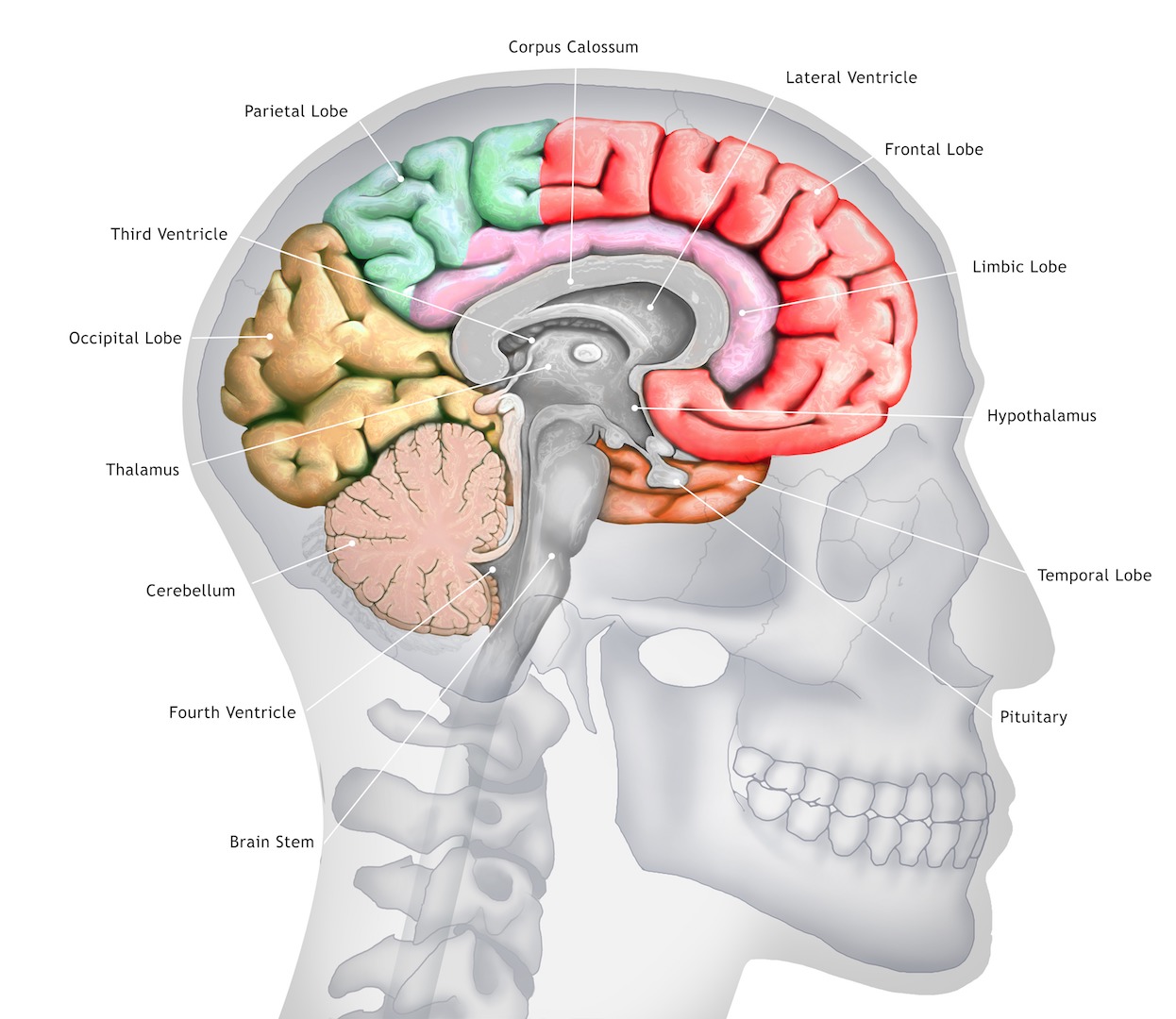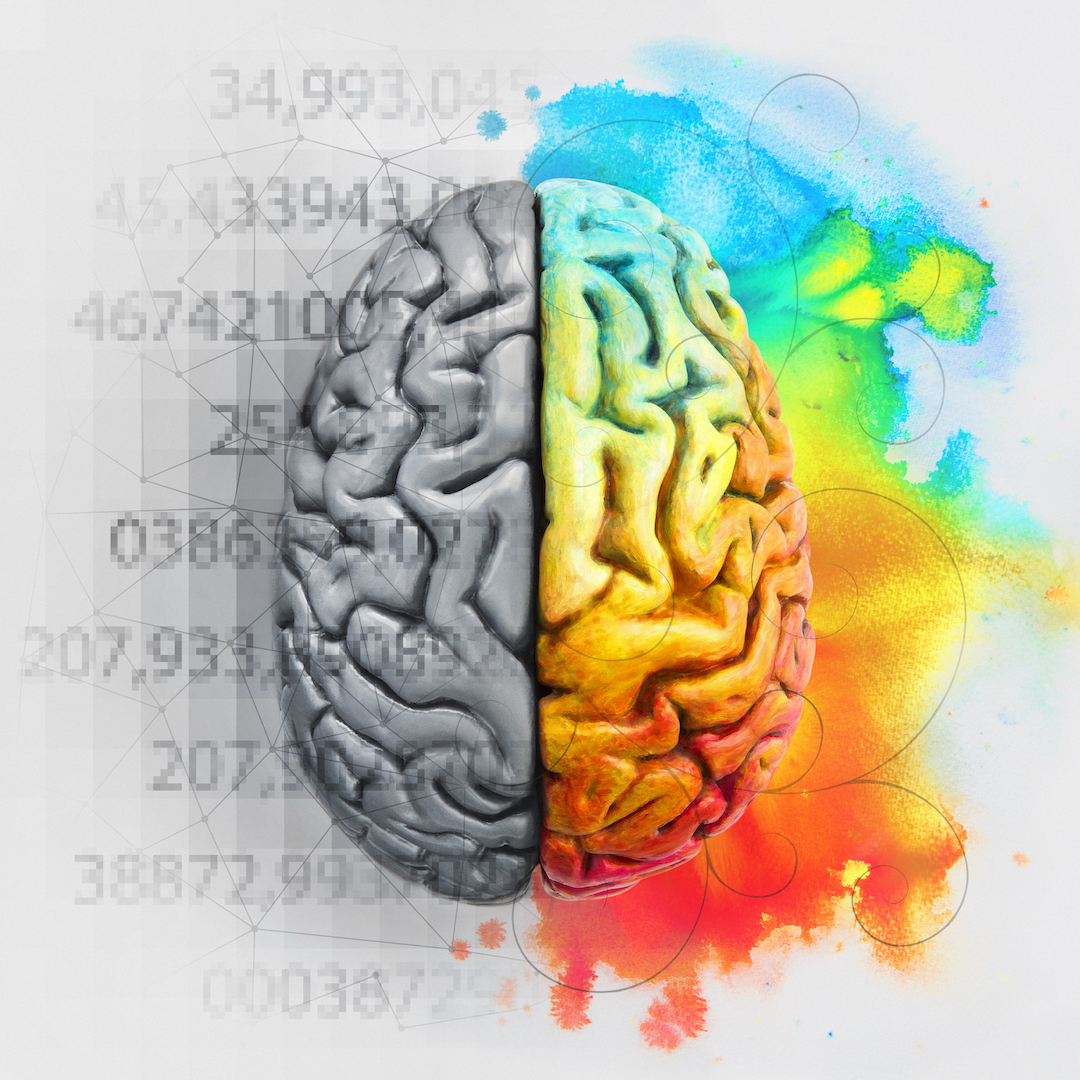Human brain: Facts, functions & anatomy
The human brain is the command center for the human nervous system.

The human brain is the command center for the human nervous system. It receives signals from the body's sensory organs and outputs information to the muscles. The human brain has the same basic structure as other mammal brains but is larger in relation to body size than the brains of many other mammals, such as dolphins, whales and elephants.
How much does a human brain weigh?
The human brain weighs about 3 lbs. (1.4 kilograms) and makes up about 2% of a human's body weight. On average, male brains are about 10% larger than female brains, according to Northwestern Medicine in Illinois. The average male has a brain volume of nearly 78 cubic inches (1,274 cubic centimeters), while the average female brain has a volume of 69 cubic inches (1,131 cubic cm). The cerebrum, which is the main part of the brain located in the front area of the skull, makes up 85% of the brain's weight.
How many brain cells does a human have?
The human brain contains about 86 billion nerve cells (neurons) — called "gray matter," according to a 2012 study published in the Proceedings of the National Academy of Sciences. The brain also has about the same number of non-neuronal cells, such as the oligodendrocytes that insulate neuronal axons with a myelin sheath. This gives axons (thin strands through which electrical impulses are transmitted between neurons) a white appearance, and so these axons are called the brain's "white matter."
Other cool facts about the brain
- The brain can't multitask, according to the Dent Neurologic Institute. Instead, it switches between tasks, which increases errors and makes things take longer.
- The human brain triples in size during the first year of life and reaches full maturity at about age 25.
- Humans use all of the brain all of the time, not just 10% of it.
- The brain is 60% fat, according to Northwestern Medicine.
- The human brain can generate 23 watts of electrical power — enough to fuel a small lightbulb.
Anatomy of the human brain
The largest part of the human brain is the cerebrum, which is divided into two hemispheres, according to the Mayfield Clinic. Each hemisphere consists of four lobes: the frontal, parietal, temporal and occipital. The rippled surface of the cerebrum is called the cortex. Underneath the cerebrum lies the brainstem, and behind that sits the cerebellum.
The frontal lobe is important for cognitive functions, such as thought and planning ahead, and for the control of voluntary movement. The temporal lobe generates memories and emotions. The parietal lobe integrates input from different senses and is important for spatial orientation and navigation. Visual processing takes place in the occipital lobe, near the back of the skull.
The brainstem connects to the spinal cord and consists of the medulla oblongata, pons and midbrain. The primary functions of the brainstem include relaying information between the brain and the body; supplying most of the cranial nerves to the face and head; and performing critical functions in controlling the heart, breathing and levels of consciousness (it's involved in controlling wake and sleep cycles).
Between the cerebrum and brainstem lie the thalamus and hypothalamus. The thalamus relays sensory and motor signals to the cortex. Except for olfaction (sense of smell), every sensory system sends information through the thalamus to the cortex, according to the online textbook, "Neuroanatomy, Thalamus" (StatPublishing, 2020). The hypothalamus connects the nervous system to the endocrine system — where hormones are produced — via the pituitary gland.
Get the world’s most fascinating discoveries delivered straight to your inbox.
The cerebellum lies beneath the cerebrum and has important functions in motor control. It plays a role in coordination and balance and may also have some cognitive functions.
The brain also has four interconnected cavities, called ventricles, which produce what's called cerebrospinal fluid (CSF). This fluid circulates around the brain and spinal cord, cushioning it from injury, and is eventually absorbed into the bloodstream.
In addition to cushioning the central nervous system, CSF clears waste from the brain. In what's called the glymphatic system, waste products from the interstitial fluid surrounding brain cells move into the CSF and away from the brain, according to the Society for Neuroscience. Studies suggest this waste clearance process mostly happens during sleep. In a 2013 Science paper, researchers reported that when mice were asleep, their interstitial spaces expanded by 60%, and the brain's glymphatic system cleared beta-amyloid (the protein that makes up Alzheimer's disease's hallmark plaques) faster than when the rodents were awake. Clearing potentially neurotoxic waste from the brain or "taking out the trash" through the glymphatic system could be one reason that sleep is so important, the authors suggested in their paper.
Is brain size linked to intelligence?
Overall brain size doesn't correlate with level of intelligence for non-human animals. For instance, the brain of a sperm whale is more than five times heavier than the human brain, but humans are considered to be of higher intelligence than sperm whales. A more accurate measure of an animal's likely intelligence is the ratio between the size of the brain and body size, although not even that measure puts humans in first place: The tree shrew has the highest brain-to-body ratio of any mammal, according to BrainFacts.org, a website produced by the Society for Neuroscience.
Among humans, brain size doesn't indicate a person's level of intelligence. Some geniuses in their field have smaller-than-average brains, while others have brains that are larger than average, according to Christof Koch, a neuroscientist and president of the Allen Institute for Brain Science in Seattle. For example, compare the brains of two highly acclaimed writers. The Russian novelist Ivan Turgenev's brain was found to weigh 71 ounces (2,021 grams), while the brain of French writer Anatole France weighed only 36 ounces (1,017 g).
The reason behind humans' intelligence, in part, is neurons and folds. Humans have more neurons per unit volume than other animals, and the only way they can all fit within the brain's layered structure is to make folds in the outer layer, or cortex, said Dr. Eric Holland, a neurosurgeon and cancer biologist at the Fred Hutchinson Cancer Research Center and the University of Washington.
"The more complicated a brain gets, the more gyri and sulci, or wiggly hills and valleys, it has," Holland told Live Science. Other intelligent animals, such as monkeys and dolphins, also have these folds in their cortex, whereas mice have smooth brains, he said.
How the brain is integrated also seems to matter when it comes to intelligence. A genius among geniuses, Albert Einstein had an average size brain; researchers suspect his mind-boggling cognitive abilities may have stemmed from its high connectivity, with several pathways connecting distant regions of his brain, Live Science previously reported.
Humans also have the largest frontal lobes of any animal, Holland said. The frontal lobes are associated with higher-level functions such as self-control, planning, logic and abstract thought — basically, "the things that make us particularly human," he said.
What's the difference between the left brain and right brain?
The human brain is divided into two hemispheres, the left and right, connected by a bundle of nerve fibers called the corpus callosum. The hemispheres are strongly, though not entirely, symmetrical. Generally, the left brain controls the muscles on the right side of the body, and the right brain controls the left side. One hemisphere may be slightly dominant, as with left- or right-handedness.
Related: What's the difference between the right brain and the left brain?
The popular notions about "left brain" and "right brain" qualities are generalizations that are not well supported by evidence. However, there are some important differences between these areas. The left brain contains regions that are involved in language production and comprehension (called Broca's area and Wernicke's area, respectively) and is also associated with mathematical calculation and fact retrieval, Holland said. The right brain plays a role in visual and auditory processing, spatial skills and artistic ability — more instinctive or creative things, Holland said — though these functions involve both hemispheres. "Everyone uses both halves all the time," he said.
BRAIN Initiative
In April 2013, President Barack Obama announced a scientific grand challenge known as the BRAIN Initiative, short for Brain Research through Advancing Innovative Neurotechnologies. The $100-million-plus effort aimed to develop new technologies to produce a dynamic picture of the human brain, from the level of individual cells to complex circuits.
Like other major science efforts, such as the Human Genome Project, the significant expense is usually worth the investment, Holland said. Scientists hope the increased understanding will lead to new ways to treat, cure and prevent brain disorders.
The project contains members from several government agencies, including the National Institutes of Health (NIH), the National Science Foundation (NSF) and the Defense Advanced Research Projects Agency (DARPA), as well as private research organizations, including the Allen Institute for Brain Science and the Howard Hughes Medical Institute.
In May 2013, the project's backers outlined their goals in the journal Science. In September 2014, the NIH announced $46 million in BRAIN Initiative grants. Industry members pledged another $30 million to support the effort, and major foundations and universities also agreed to apply more than $240 million of their own research toward BRAIN Initiative goals.
When the project was announced, President Obama convened a commission to evaluate the ethical issues involved in research on the brain. In May 2014, the commission released the first half of its report, calling for ethics to be integrated early and explicitly in neuroscience research, Live Science previously reported. In March 2015, the commission released the second half of the report, which focused on issues of cognitive enhancement, informed consent and using neuroscience in the legal system, Live Science reported.
The Brain Initiative has achieved several of its goals. As of 2018, the NIH has "invested more than $559 million in the research of more than 500 scientists," and Congress appropriated "close to $400 million in NIH funding for fiscal year 2018," according to the initiative's website. The research funding facilitated the development of new brain-imaging and brain-mapping tools, and helped create the BRAIN Initiative Cell Census Network (BICCN) — an effort to catalog the brain's "parts' list." The BICCN released its first results in November 2018.
Beyond a parts list, the BRAIN Initiative is working to develop a detailed picture of the circuits in the brain. For example, in 2020, BRAIN Initiative researchers published a study in the journal Neuron, reporting that they had developed a system, tested in mice, to control and monitor circuit activity at any depth in the brain. Previous efforts could only examine circuits close to the surface of the brain. Also in 2020, the initiative's Machine Intelligence from Cortical Networks (MICrONS) program, an effort to map circuits in the cortex, launched a website where researchers can share their data, including electron microscopy images of circuits.
Since 2019, the initiative has sponsored a photo and video contest in which initiative researchers are invited to submit eye-catching depictions of the brain. Check out the 2020 winners on the Brain Initiative website.
Does the brain stay alive after a person dies?
April 2019 marked a milestone for both the initiative and neuroscience research at large: BRAIN Initiative researcher Nenad Sestan, of the Yale School of Medicine, published a report in the journal Nature, revealing that his research team had restored circulation and some cellular functions to pig brains four hours after the animals' deaths, Live Science previously reported. The results challenged the prevailing view that brain cells are suddenly and irreversibly damaged shortly after the heart stops beating. The researchers did not observe any signs of consciousness in the brains, nor were they trying to; on the contrary, the researchers injected pig brains with chemicals that mimicked blood flow and also blocked neurons from firing. The researchers emphasized that they did not bring the pig brains back to life. They did, however, restore some of their cellular activity.
Additional resources
- "Evolution of the brain and intelligence," by Gerhard Roth and Ursula Dicke, in Trends in Cognitive Sciences (May 2005)
- NIH: The BRAIN Initiative
- NSF: Understanding the brain
This article was updated on May 28, 2021 by Live Science contributor Ashley P. Taylor.






